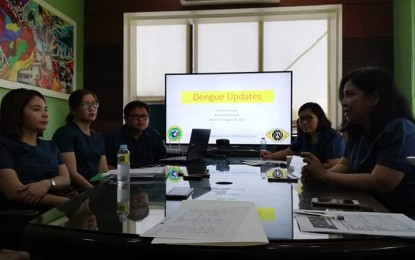
DOWNTREND. Dengue cases in Western Visayas are declining but still unstable, according to the region’s Department of Health - Center for Health Development. In a press conference on Monday (August 19, 2019), DOH-CHD Western Visayas senior program health officer Josef Alexander Denila said that as of August 10, the region had 36,117 cases with 164 deaths. (PNA photo by PGLena)
ILOILO CITY – Dengue cases in Western Visayas are on the decline but remain above the epidemic threshold, data from the Regional Epidemiology and Surveillance Unit (RESU) of the Department of Health - Center for Health Development (DOH-CHD) showed.
In a press conference on Monday, DOH-CHD 6 (Western Visayas) senior program health officer Josef Alexander Denila said that from January 1 to August 10, the region had recorded 36,117 cases with 164 deaths, marking a 362 percent increase from the 7,819 cases and 57 deaths in the same period last year.
However, Denila cited that from morbidity week (MW) 28 in the second week of July to MW 29, cases began to decline by about 5 percent from 4,466 to 4,250, and further to 3,912 in the following week.
“We peaked at morbidity week 29 and from there, we started to decline,” he said, noting that cases in Aklan have started to plateau.
Those in Antique, Capiz, Guimaras, and Negros Occidental were declining, while those in Iloilo province and Iloilo City were also on a downward trend but remained erratic.
Guimaras still had the highest attack rate and with the highest increase in cases.
The decrease in cases has been attributed to the vigilance of the public to seek early consultation once they feel dengue signs and symptoms; and good surveillance conducted by health officials and vector control measures initiated by local government units, among others.
“Considering that it is still erratic, as much as possible, we should not be complacent. We know for a fact that as long as the vector is there, they can still transmit the dengue virus,” said medical program coordinator, Dr. Rosemarie Lamirez.
Lamirez said they have received guidelines from the central office on how to conduct proper monitoring of cases from the regional down to the household level.
“There is a set of questionnaires to assure the proper care and management of dengue cases and also determine what is being done in response to the dengue outbreak,” she said.
While a national epidemic has been declared, DOH records showed that the provinces of Iloilo, Aklan, and Guimaras; the towns of Culasi, Balete, and Tobias Fornier in Antique; Maasin, Iloilo; Balete, Aklan; Sigma, Capiz; Cauayan, Negros Occidental and Iloilo City have already been placed under a state of calamity due to dengue. (PNA)
